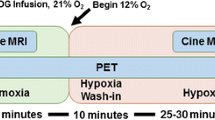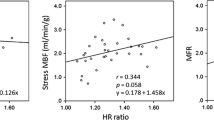Abstract
Background
Preserved myocardial oxygen consumption estimated by carbon 11-acetate and positron emission tomography (PET) in myocardial regions with chronic but reversibly depressed contractile function in patients with ischemic heart disease have been suggested to be caused by repeated short episodes of acute myocardial ischemia. To evaluate this hypothesis myocardial 11C-acetate PET imaging was performed before and after acute repetitive myocardial ischemia.
Methods and Results
In open chest dogs (n=8), the left anterior descending coronary artery was occluded 4 times for 5 minutes alternating with 5 minutes of reperfusion. Before and after repetitive coronary occlusions, oxygen 15 water/oxygen 15 carbon monoxide (blood flow), and 11C-acetate (oxygen consumption) PET imaging were performed. Left ventricular regional systolic wall thickening was measured with sonomicrometry. Forty-five minutes after the ischemic episodes, systolic ventricular wall thickening was decreased by 90%, whereas myocardial blood flow was reduced by 21% compared with baseline values (P<.05). Ninety minutes after the ischemic episodes, estimated oxygen consumption was unaltered compared with the baseline level despite a sustained 70% decrease in the regional contractile function (P<.05).
Conclusions
Oxygen consumption estimated by 11C-acetate PET imaging is preserved after repeated episodes of acute myocardial ischemia despite a severe impairment of contractile function.
Similar content being viewed by others
References
Brown M, Marshall DR, Sobel BE, Bergmann SR. Delineation of myocardial oxygen utilization with carbon-11-labeled acetate. Circulation 1987;76:687–96.
Buxton DB, Schwaiger M, Nguyen A, Phelps ME, Schelbert HR. Radiolabeled acetate as a tracer of myocardial tricarboxylic acid cycle flux. Circ Res 1988;63:628–34.
Armbrecht JJ, Buxton DB, Brunken RC, Phelps ME, Schelbert HR. Regional myocardial oxygen consumption determined noninvasively in humans with [1–11C] acetate and dynamic positron tomography. Circulation 1989;80:863–72.
Armbrecht JJ, Buxton DB, Schelbert HR. Validation of 11C-acetate as a tracer for noninvasive assessment of oxidative metabolism with positron emission tomography in normal, ischemic, postischemic, and hyperemic canine myocardium. Circulation 1990;81:1594–605.
Ng CK, Huang SC, Schelbert HR, Buxton DB. Validation of a model for 11C-acetate as a tracer of cardiac oxidative metabolism. Am J Physiol 1994;266:H1304–15.
Sun KT, Yeatman LA, Buxton DB, Chen K, Johnson JA, Huang SC, et al. Simultaneous measurement of my ocardial oxygen consumption and blood flow using [1-carbon-11] acetate. J Nucl Med 1998;39:272–80.
Sun KT, Chen K, Huang SC, Buxton DB, Hansen HW, Kim AS, et al. Compartment model for measuring myocardial oxygen consumption using 11C-acetate. J Nucl Med 1997;38:459–66.
Gropler RJ, Geltman EM, Sampathkumaran K, Perez JE, Moerlein SM, Sobel BE, et al. Functional recovery after coronary revascularization for chronic coronary artery disease is dependent on maintenance of oxidative metabolism. J Am Coll Cardiol 1992;20:569–77.
Vanoverschelde JL, Wijns W, Depre C, Essamri B, Heyndrickx GR, Borgers M, et al. Mechanisms of chronic regional postischemic dysfunction in humans. New insights from the study of noninfarcted collateral-dependent myocardium. Circulation 1993;87:1513–23.
Wolpers HG, Burchert W, van-den-Hoff J, Weinhardt R, Meyer GJ, Lichtlen PR. Assessment of myocardial viability by use of 11C-acetate and positron emission tomography. Threshold criteria of reversible dysfunction. Circulation 1997;95:1417–24.
Heyndrickx GR, Millard RW, McRitchie RJ, Maroko PR, Vatner SF. Regional myocardial functional and electrophysiological alterations after brief coronary artery occlusion in conscious dogs. J Clin Invest 1975;56:978–85.
Marinho NV, Keogh BE, Costa DC, Lammerstma AA, Ell PJ, Camici PG. Pathophysiology of chronic left ventricular dysfunction. New insights from the measurement of absolute myocardial blood flow and glucose utilization. Circulation 1996;93:737–44.
Conversano A, Walsh JF, Geltman EM, Perez JE, Bergmann SR, Gropler RJ. Delineation of myocardial stunning and hibernation by positron emission tomography in advanced coronary artery disease. Am Heart J 1996;131:440–50.
Bolli R, Zughaib M, Li XY, Tang XL, Sun JZ, Triana JF, et al. Recurrent ischemia in the canine heart causes recurrent bursts of free radical production that have a cumulative effect on contractile function. A pathophysiological basis for chronic myocardial “stunning”. J Clin Invest 1995;96:1066–84.
Wijns W, Vatner SF, Camici PG. Hibernating my ocardium. N Engl J Med 1998;339:173–81.
Shen YT, Vatner SF. Mechanism of impaired myocardial function during progressive coronary stenosis in conscious pigs. Hibernation versus stunning? Circ Res 1995;76:479–88.
Vinten-Johansen J, Gayheart PA, Johnston WE, Julian JS, Cordell AR. Regional function, blood flow, and oxygen utilization relations in repetitively occluded reperfused canine myocardium. Am J Physiol 1991;261:H538–47.
Chiu WC, Kedem J, Scholz PM, Weiss HR. Regional asynchrony of segmental contraction may explain the “oxygen consumption paradox” in stunned myocardium. Basic Res Cardiol 1994;89:149–62.
Hacker TA, Renstrom B, Nellis SH, Liedtke AJ. Effect of repetitive stunning on myocardial metabolism in pig hearts. Am J Physiol 1997;273:H1395–1402.
Svendsen JH, Bjerrum PJ, Haunsø S. Myocardial capillary permeability after regional ischemia and reperfusion in the in vivo canine heart. Effect of superoxide dismutase. Circ Res 1991;68:174–84.
Rota Kops E, Herzog H, Schmid A, Holte S, Feinendegen LE. Performance characteristics of an eight-ring whole body PET scanner. J Comput Assist Tomogr 1990;14:437–45.
Iida H, Takahashi A, Tamura Y, Ono Y, Lammertsma AA. Myocardial blood flow: comparison of oxygen-15-water bolus injection, slow infusion and oxygen-15-carbon dioxide slow inhalation. J Nucl Med 1995;36:78–85.
Knight RJ, Kofoed KF, Schelbert HR, Buxton DB. Inhibition of glycer-aldehyde-3-phosphate dehydrogenase in post-ischaemic myocardium. Cardiovasc Res 1996;32:1016–23.
Kofoed KF, Schöder H, Knight RJ, Buxton DB. Glucose metabolism in reperfused myocardium measured by [2-18F] 2-fluorodeoxyglucose and PET. Cardiovasc Res 1999;45:321–9.
Iida H, Kanno I, Takahashi A, Miura S, Murakami M, Takahashi K, et al. Measurement of absolute myocardial blood flow with H215O and dynamic positron-emission tomography. Strategy for quantification in relation to the partial-volume effect. Circulation 1988;78:104–15.
Iida H, Rhodes CG, de-Silva R, Araujo LI, Bloomfield PM, Lammertsma AA, et al. Use of the left ventricular time-activity curve as a noninvasive input function in dynamic oxygen-15-water positron emission tomography. J Nucl Med 1992;33:1669–77.
Bolli R, Marban E. Molecular and cellular mechanisms of myocardial stunning. Physiol Rev 1999;79:609–34.
Buxton DB, Mody FV, Krivokapich J, Phelps ME, Schelbert HR. Quantitative assessment of prolonged metabolic abnormalities in reperfused canine my ocardium. Circulation 1992;85:1842–56.
Bergmann SR, Weinheimer CJ, Brown MA, Perez JE. Enhancement of regional myocardial efficiency and persistence of perfusion, oxidative, and functional reserve with paired pacing of stunned myocardium. Circulation 1994;89:2290–96.
Høst N, Peuhkurinen K, Haunsø S, Hassinen I. Evaluation of reperfusion strategy for the globally ischemic rat heart. Recovery of function and energy metabolism. Cardiovasc Res 1992;26:502–7.
Bolli R, Triana JF, Jeroudi MO. Prolonged impairment of coronary vasodilation after reversible ischemia. Evidence for microvascular “stunning.” Circ Res 1990;67:332–43.
Sherman AJ, Harris KR, Hedjbeli S, Yaroshenko Y, Schafer D, Shroff S, et al. Proportionate reversible decreases in systolic function and myocardial oxygen consumption after modest reductions in coronary flow: hibernation versus stunning. J Am Coll Cardiol 1997;29:1623–31.
Hansen PR. Myocardial reperfusion injury: experimental evidence and clinical relevance. Eur Heart J 1995;16:734–40.
Vanoverschelde JL, Wijns W, Borgers M, Heyndrickx G, Depre C, Flameng W, et al. Chronic myocardial hibernation in humans. From bedside to bench. Circulation 1997:95:1961–71.
Camici PG, Rimoldi O. Blood flow in myocardial hibernation. Curr Opin Cardiol 1998;13:409–14.
Ikeda H, Koga Y, Kuwano K, Nakayama H, Ueno T, Yoshida N, et al. Cyclic flow variations in a conscious dog model of coronary artery stenosis and endothelial injury correlate with acute ischemic heart disease syndromes in humans. J Am Coll Cardiol 1993;21:1008–17.
Schulz R, Kappeler C, Coenen H, Bockisch A, Heusch G. Positron emission tomography analysis of [1-(11)C] acetate kinetics in shortterm hibernating myocardium. Circulation 1998;97:1009–16.
Author information
Authors and Affiliations
Corresponding author
Additional information
This study was supported by the Danish Heart Foundation, the Alfred Benzon Foundation, the John and Birthe Meyer foundation, the Laerdal foundation, the Foundation of 1921, and the Foundation of 1870.
Rights and permissions
About this article
Cite this article
Kofoed, K.F., Hansen, P.R., Holm, S. et al. Regional myocardial oxygen consumption estimated by carbon-11 acetate and positron emission tomography before and after repetitive ischemia. J Nucl Cardiol 7, 228–234 (2000). https://doi.org/10.1016/S1071-3581(00)70011-0
Received:
Accepted:
Issue Date:
DOI: https://doi.org/10.1016/S1071-3581(00)70011-0




